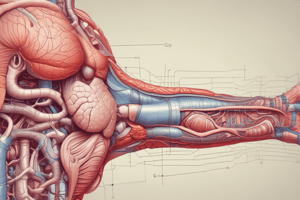Podcast
Questions and Answers
Match the following structures in the mouth with their functions:
Match the following structures in the mouth with their functions:
Incisors = Cutting and biting Canines = Piercing and tearing Premolars = Crushing and grinding Molars = Grinding and crushing
Match the following substances in saliva with their functions:
Match the following substances in saliva with their functions:
Amylase = Breaks down carbohydrates Lipase = Breaks down fats Mucus = Moistens food for swallowing Enzymes = Breaks down proteins
Match the following processes in the esophagus with their descriptions:
Match the following processes in the esophagus with their descriptions:
Peristalsis = Wave-like muscle contractions that propel food downwards Swallowing = Food is pushed to the back of the mouth by the tongue Gastric emptying = Partially digested food enters the small intestine Gastric digestion = Mixing of food with stomach acid and enzymes for 1-2 hours
Match the following substances in the stomach lining with their functions:
Match the following substances in the stomach lining with their functions:
Match the following processes in the small intestine with their descriptions:
Match the following processes in the small intestine with their descriptions:
Match the following functions in the large intestine with their descriptions:
Match the following functions in the large intestine with their descriptions:
Flashcards are hidden until you start studying
Study Notes
Digestive System
Mouth and Teeth
- Primary function: mechanical breakdown of food into smaller particles (chewing)
- Teeth:
- Incisors: cutting and biting
- Canines: piercing and tearing
- Premolars: crushing and grinding
- Molars: grinding and crushing
- Saliva:
- Produced by salivary glands
- Contains enzymes (amylase and lipase) to break down carbohydrates and fats
- Moistens food for swallowing
Esophagus and Swallowing
- Muscular tube that transports food from the mouth to the stomach
- Peristalsis: wave-like muscle contractions that propel food downwards
- Swallowing process:
- Food is pushed to the back of the mouth by the tongue
- Food enters the pharynx (throat)
- Epiglottis closes the trachea (windpipe) to prevent food from entering the lungs
- Food enters the esophagus and is propelled to the stomach
Stomach Acid and Digestion
- Primary function: chemical breakdown of proteins and absorption of nutrients
- Stomach lining secretes:
- Hydrochloric acid (HCl) to denature proteins and activate digestive enzymes
- Pepsin: breaks down proteins into peptides and amino acids
- Mucus: protects the stomach lining from acid and enzymes
- Gastric digestion: mixing of food with stomach acid and enzymes for 1-2 hours
- Gastric emptying: partially digested food (chyme) enters the small intestine
Small Intestine Absorption
- Primary function: absorption of nutrients into the bloodstream
- Long, thin, and highly folded to increase surface area
- Finger-like projections (villi) and microvilli increase surface area for absorption
- Absorption of:
- Carbohydrates: broken down into glucose
- Proteins: broken down into amino acids
- Fats: broken down into fatty acids and glycerol
- Absorbed nutrients enter the bloodstream and are transported to the liver for processing
Large Intestine and Waste Removal
- Primary function: water absorption, electrolyte absorption, and waste storage
- Also known as the colon
- Water and electrolyte absorption:
- Water is reabsorbed into the bloodstream
- Electrolytes (e.g., sodium, potassium) are reabsorbed and regulated
- Waste storage:
- Feces are formed and stored in the rectum
- Defecation: waste is eliminated from the body through the anus
Studying That Suits You
Use AI to generate personalized quizzes and flashcards to suit your learning preferences.




